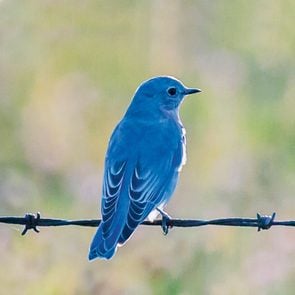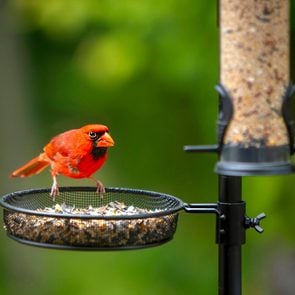Why the Common Loon is Anything But Common
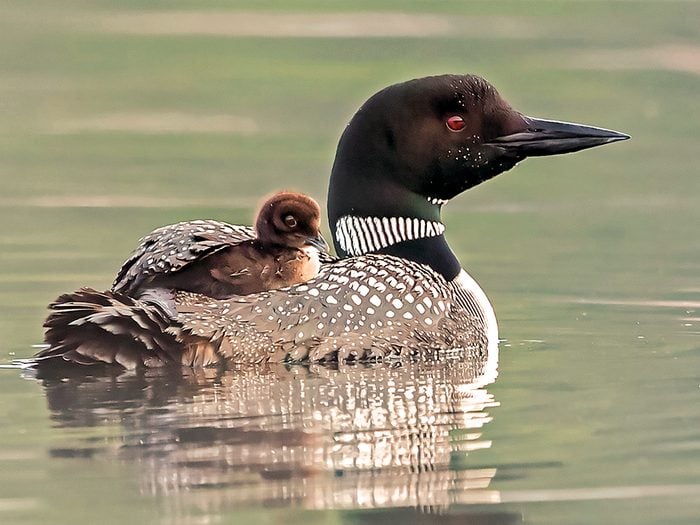
A few fun facts and features about one of Canada's most iconic birds.
There really is nothing common about the common loon. From its eerily haunting calls, iridescent plumage, brilliant scarlet-red eyes, legs set awkwardly far back and large webbed feet, to its pure natural beauty, it would have been more fittingly named the uncommon loon.
The common loon’s taxonomic name, Gavia immer, comes from gavia—Latin for “ancient seabird”—and immer—derived from the Latin immergo (to plunge) or directly from the Norwegian for “great northern diver.” Able to plunge to depths of 200 feet, remain submerged for several minutes and fly nonstop across hundreds of miles in a single flight, the common loon is truly a Superman in the aquatic-bird world.
Its English name, loon, comes from its awkwardness on land. With legs and large webbed feet back near the end of its body, underwater it’s a streamlined, extremely fast and agile bird torpedo. On land, however, due to the rearward position of its legs and feet, it looks like a bit of a drunken sailor.
Except when in flight, loons leave the water only to mate or incubate eggs in their nests. A loon found on land for any other reason is like a fish out of water and is probably sick or injured, or has somehow missed its watery runway and either needs help to return to the water or an immediate rescue.
The Eyes Have It
The loon’s brilliant red eyes aren’t that colour by accident or to enhance its dashing good looks; there’s a real science behind them. If you’ve ever gone snorkelling or scuba diving and own a GoPro camera, you’ll know that a red filter is a must-have underwater. Well, needless to say, the common loon had the science eons before GoPro.
Water absorbs light, and colour is simply different wavelengths or particles of light. Red light has the longest wavelength of visible colours, therefore it has the least amount of energy. This energy is absorbed underwater at a depth of 12-15 feet, so the colour disappears; a bit deeper, orange and then yellow follow. By the time the loon reaches a depth of 50-60 feet, all low-energy light and colour are gone. Everything would appear a muted bluish-green—as only these shorter wavelengths remain—if not for the loon’s red eyes, filtering these colours out. The red not only returns some natural colour to the underwater world at depth, but, more importantly, adds a greater distinguishable contrast between prey and its environment, allowing the loon to easily spot the fish, crustaceans and insect larvae that would have been otherwise perfectly colour-muted and camouflaged.
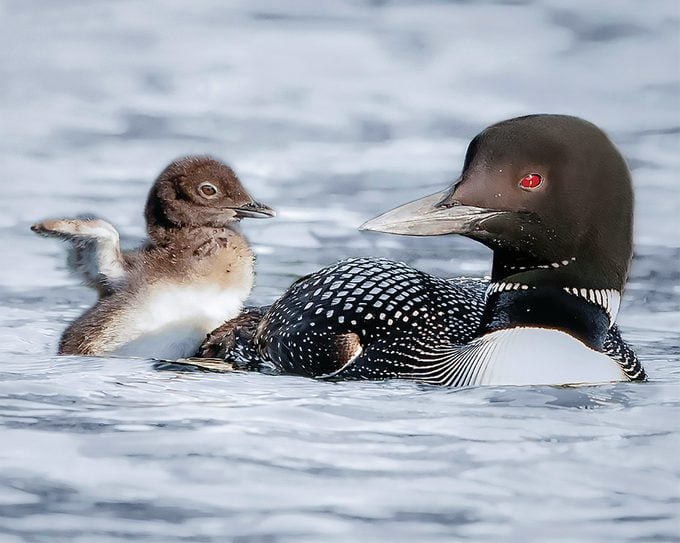
Together Forever (Sometimes)
Living for up to 30 years, it was once thought that loon couples mated for life. New research suggests that territory eclipses monogamy, however, and a mother bird having the ideal place to raise her chicks takes priority. Transient bachelor loons may launch challenges for territory; if successful, the resident male is driven off, with the intruder acquiring not only his territory but also his mate. However, a mated pair that can defend and retain their territory will remain together for many years, returning to Canada from their ocean vacations on the Gulf Coast or in Mexico each spring to nest and raise a family. Loons typically refurbish the previous year’s nest, and the female then lays one or two eggs. These take about four weeks to hatch, with chicks arriving sometime in late June or early July. Once hatched, these tiny brown fluffball chicks are able to swim immediately and never return to the nest, preferring instead to ride high or to tuck under the wing of either mom or dad, which offers both warmth and protection. The chicks, however, grow quickly and their hitchhiking ends after about two weeks, as they now begin to dive, explore and develop independence. At four weeks, the chicks can dive and procure some of their own food, often being left alone while mom and dad go off socializing at neighbouring lakes. By eight weeks, the chicks are mostly able to provide for themselves and are left alone overnight and for extended periods. At 12 weeks, they have now fledged and, with the ability to fly, are completely independent of their parents, with the time drawing near for their winter migration.
How many of these beautiful Canadian birds have you spotted?
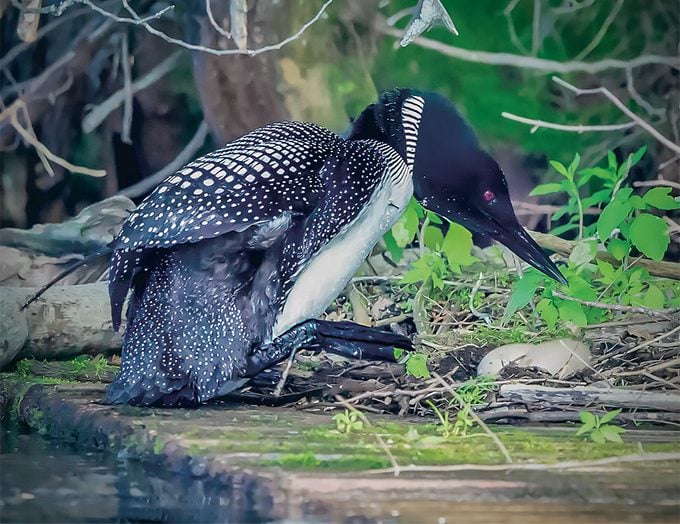
The Common Loon is At Risk
The haunting tremolo call of the loon is an iconic wilderness or cottage experience during our Canadian summers, and I just cannot imagine sitting dockside or dipping my paddle and not hearing it. Sadly, the common loon is on the decline in Canada, with culprits such as water acidification, mercury pollution, habitat loss and habitat disruption by humans cited as key elements in this reduction.
At my own cottage in Haliburton, Ontario, the number of cottages on our lake has more than doubled in the past 20 years and, thus, so has the number of people, boats, personal watercraft and fishing enthusiasts. I first became aware of the effects this was having on our loons seven years ago when, for three consecutive years, no chicks were hatched, and although eggs had been laid in each nest, both the eggs and nests had been abandoned. What most people don’t know is that loons are highly sensitive to stressors such as people and boat traffic; and with loon nesting coinciding with the May 24 long weekend, as well as the opening of bass season on the third Saturday in June, the human pressures were just too great for them and they had flown the coop, so to speak. After observing nest disruption by fishers, who oftentimes would cast their lines right at the nests, and with the loons being further bombarded by the onslaught of noisy jet skis zooming in and around the shallow back bays, it was time for me to launch into a plan of affirmative action.
Each spring, once our docks are back in place and our pontoon boat is launched, I load up the boat with floats, anchors and signs. I design these signs and have them printed on weatherproof chloroplast, which I secure to floats and then anchor at the mouths of the shallow quiet bays where the loons prefer to nest. My signs are pretty matter of fact, citing the Migratory Birds Convention Act of 1994 and asking that everyone help protect our wildlife. At first, I wasn’t quite sure how cottagers and other people would react to my signs and the temporarily restricted access to areas of the lake; but, surprisingly, 99 percent would stop, read the signage and just respectfully turn around. Overall, the signage has had great success in that not only do we now have loon chicks every year, but many of our cottagers have since become stewards and protectors of our loons. I think the greatest thing I have learned from this experience is that it’s not that people don’t care, it’s that they just don’t know. Once they’re enlightened and provided with information, they do want to help and will do the right thing.
Discover Canada’s best bird-watching spots.
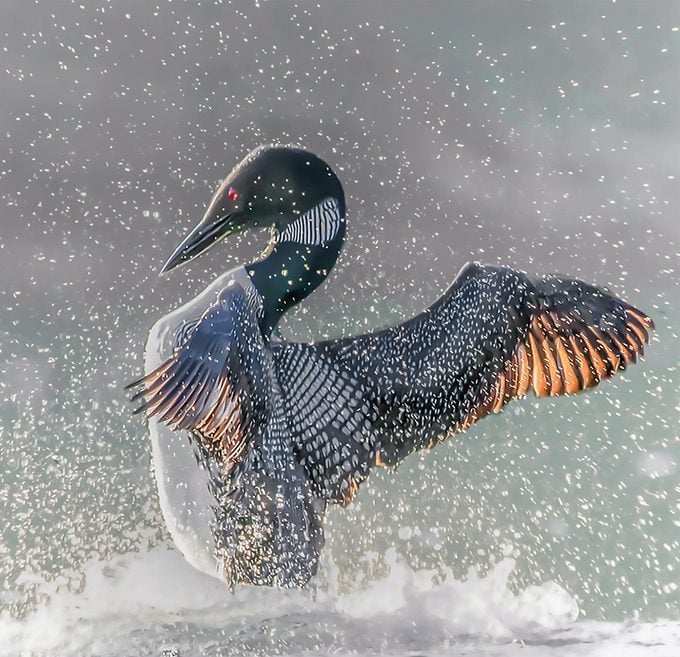
What You Can Do to Save the Common Loon
As Canadians, we all love our summers—and there’s nothing quite like summer on the water or at the cottage. But our loons and other wildlife account for an integral part of the Canadian experience, so please be mindful and respectful. Loons enjoy shallow regions, back bays, and areas along shorelines, so if you have the need for speed, please take it away from these nesting and nursery areas, as loon chicks are almost impossible to spot on the water and may not be able to dive down to escape your boat.
All animals have what is called a buffer zone, which is simply the distance between you and them that they are comfortable with. When you breach this zone, you incite either a fight or flight reaction. Loons, being very sensitive and easily stressed, will abandon their nests and even their chicks if continually intruded upon. As a rule of thumb, a buffer zone of 400 feet while nesting and 100 feet two weeks after chicks have been hatched should be observed.
When a common loon stands tall upon the water and wildly flaps its wings—known as a penguin dance—and repeats an excited, wavering call referred to as a tremolo, it is not showing off, nor is it happy to see you. On the contrary, your close proximity is causing it great distress and you should leave immediately. This distressed display may be followed by more aggressive wing rowing, a defensive attack directed at you that puts both yourself and the loon in harm’s way. Remember, the loon’s long pointed bill is also a defensive tool, and loons have even been known to kill eagles while defending their territory or chicks. I once saw a pair of canoeists paddle too close to a mother and her two chicks—the melee that ensued caused the canoe to capsize, leaving the pair, still under attack, to abandon their vessel and swim for shore.
Brush up on the birds of Ontario’s Grey-Bruce region.
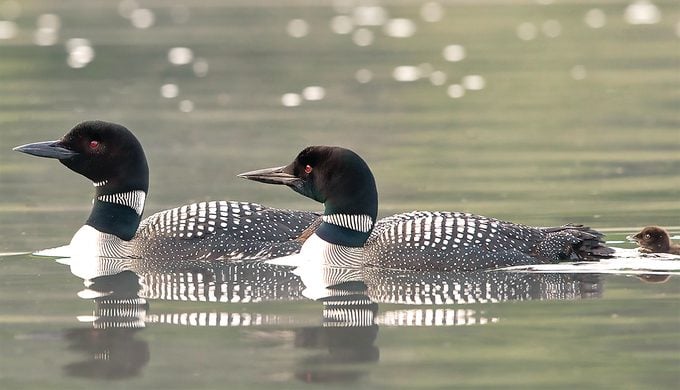
Nature Isn’t Always Kind
Of course, there are situations like entanglement—a fishing line, or a loon out of water that warrants help or rescue—but as a general rule, nature has its own design, and loon chicks and other wildlife young should be left alone. Here’s how it works: though sometimes laying only one egg, loons most often will lay two, the second egg being staggered, laid one to three days after the first. Hatching also occurs as a staggered event, giving the first hatched chick a head start on the second one. Nature, by design intends for only one chick to fledge and reach adulthood; the second chick is just nature’s insurance marker should the first chick be gobbled up by a predator or lost to a storm. Oftentimes as chicks develop and grow, the first-hatched (and therefore larger) chick will command all the food from its loon parents. It may also antagonize its smaller siblings with continual attacking and pecking. As with many avian species, siblicide is not uncommon, with the larger, first-hatched chick starving or even killing its smaller sibling so as to command all the parental attention and food supply.
On our lake several years ago, some cottagers took notice of this behaviour and, pitying the smaller loon chick, effected a rescue. They then delivered the tiny, emaciated chick to a wildlife-rescue centre nearby, where it inevitably died. The cottagers, with kind intent, thought they were doing the right thing; however, as fate would have it, only two days later, the first chick was gobbled up by a mink. Here’s the dilemma: If the cottagers had not rescued the smaller chick in the first place, with its older sibling now gone, it would have commanded undivided attention and feeding from its parents and potentially would have grown to adulthood.
The moral of the story is that nature is not always kind, but it always has a plan, so please just leave it to its intended design.
Next, check out this gorgeous gallery of Canadian bird photography.
